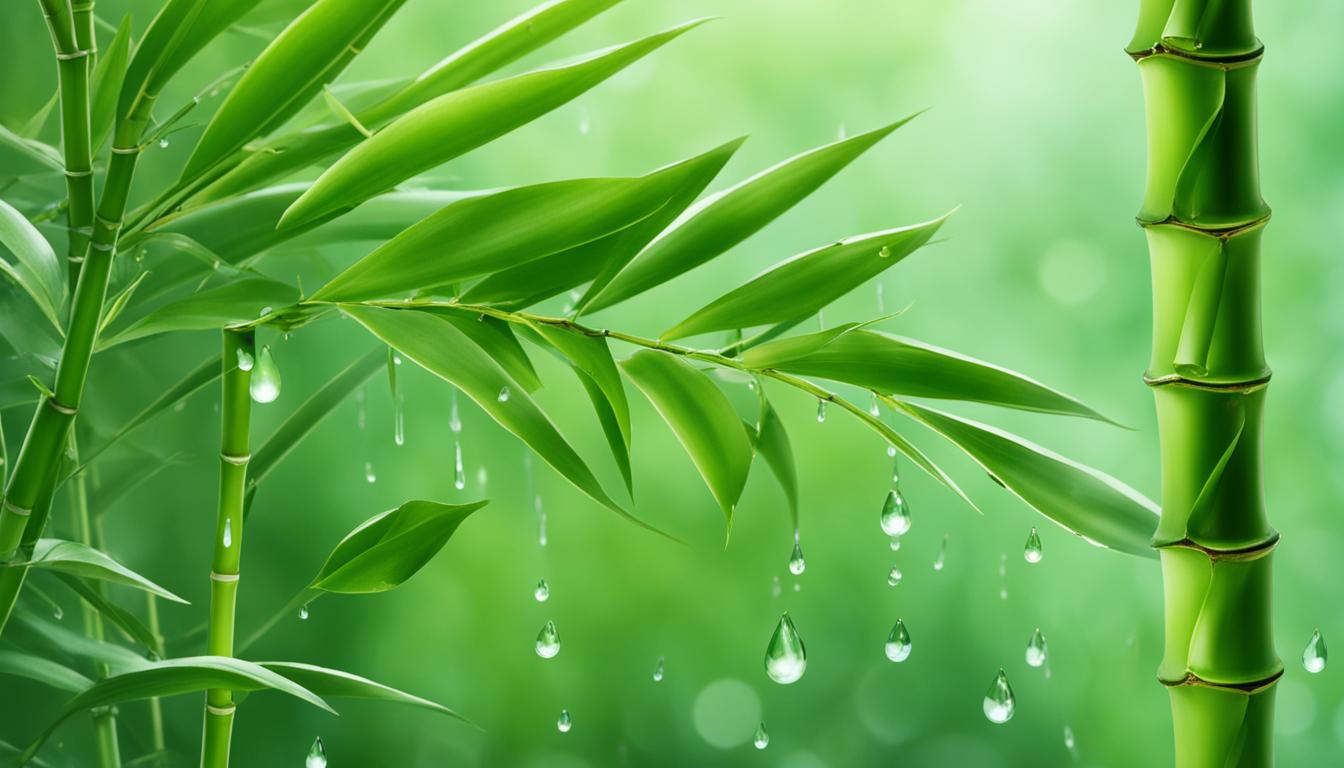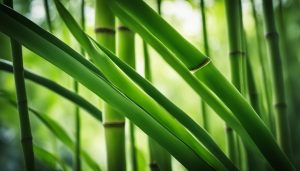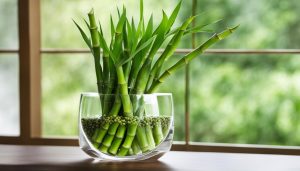Lucky bamboo, scientifically known as Dracaena sanderiana, is a popular indoor plant that symbolizes luck and prosperity. Whether you choose to grow it in soil or water, proper watering is essential for its health and longevity. In this article, we will explore the best practices for watering your lucky bamboo plant and provide useful tips to ensure its thriving growth.
Contents
- 1 Lucky Bamboo Care Tips
- 2 Sunlight and Water Requirements for Lucky Bamboo
- 3 Temperature and Toxicity Considerations for Lucky Bamboo
- 4 Training and Symbolism of Lucky Bamboo
- 5 Conclusion
- 6 FAQ
- 6.1 How often should I water a lucky bamboo plant?
- 6.2 Should I use tap water or filtered water for my lucky bamboo plant?
- 6.3 How do I know if I am giving my lucky bamboo plant the right amount of light?
- 6.4 What temperature range does lucky bamboo prefer?
- 6.5 Is lucky bamboo toxic to cats and dogs?
- 6.6 How can I train my lucky bamboo plant into different shapes?
- 6.7 What does the number of stalks in lucky bamboo represent?
- 7 Source Links
Key Takeaways:
- Keep lucky bamboo in slightly damp soil or water to maintain its health.
- If growing in water, replace it every week to prevent stagnant conditions.
- Filtered or bottled water is recommended to avoid fluoride toxicity.
- Remove yellow leaves and repot the bamboo when the roots outgrow the container.
- Ensure indirect light and temperatures between 65-95°F for optimal growth.
Lucky Bamboo Care Tips
When it comes to caring for your lucky bamboo plant, there are a few watering tips that can help ensure its health and longevity. Proper watering frequency is essential for maintaining a healthy bamboo plant.
If you are growing your lucky bamboo in water, it is important to change the water every week to prevent stagnation and the buildup of harmful bacteria. This will help keep the water clean and fresh for your plant. When changing the water, make sure to use filtered or bottled water to avoid exposing your plant to harmful chemicals that may be present in tap water. By providing your lucky bamboo with clean water, you are reducing the risk of any potential damage caused by fluoride.
For those who prefer growing lucky bamboo in soil, it is important to keep the soil slightly damp. Avoid overwatering to prevent waterlogging, which can lead to root rot and other issues. Regularly check the moisture level of the soil by inserting your finger about an inch deep into the soil. If it feels dry at that depth, it’s time to water your plant. However, if the soil feels damp, it’s best to wait before watering again.
Remember to always remove any yellow leaves promptly, as they can indicate overwatering or other issues. Additionally, repot your bamboo plant into a larger container when the roots outgrow the current container. This will give the roots more space to grow and prevent them from becoming overcrowded.
Table: Watering Tips for Lucky Bamboo Plant
| Growing Medium | Watering Frequency |
|---|---|
| Water | Change water every week |
| Soil | Keep soil slightly damp |
Sunlight and Water Requirements for Lucky Bamboo
Proper sunlight and water management are vital for the health and well-being of your lucky bamboo plant. Understanding the sunlight requirements and water needs will help ensure optimal growth and longevity.
Sunlight Requirements
Lucky bamboo plants thrive in moderate or indirect sunlight. It is important to avoid exposing them to direct sunlight, as this can lead to scorching of the leaves. If you notice scorched leaves on your plant, simply move it to an area with less intense light. Placing your lucky bamboo near a bright window without direct sun exposure is the ideal spot.
Water Requirements
The water requirements for lucky bamboo depend on whether it is grown in soil or water. If you have your bamboo plant in soil, it is recommended to keep the soil slightly damp. Be careful not to overwater or let the soil dry out completely. On the other hand, if your lucky bamboo is grown in water, make sure to keep the roots fully covered at all times. You should replace the water every 7-10 days to prevent stagnation and maintain the plant’s health.
When watering your lucky bamboo, it is essential to use filtered or bottled water. Tap water with high levels of fluoride can be toxic to the plant. By using filtered or bottled water, you avoid any potential harm to your lucky bamboo and ensure its longevity. Remember to replenish the water regularly, following the recommended frequency for your specific growing medium.
With proper sunlight exposure and regular watering, you can provide the ideal conditions for your lucky bamboo plant to thrive and bring luck and prosperity into your space.
Temperature and Toxicity Considerations for Lucky Bamboo
Lucky bamboo requires a specific temperature range to thrive and must be kept away from pets due to its toxicity. Understanding these considerations is essential for the health and well-being of your lucky bamboo plant.
Temperature Range for Good Luck Bamboo
Lucky bamboo prefers temperatures between 65-95°F (18-35°C) to maintain optimal growth. It is crucial to avoid placing your plant near heating or cooling vents, as sudden temperature fluctuations can adversely affect its health. Keep in mind that lucky bamboo is suitable for indoor cultivation, making it an excellent choice for both homes and offices.
Toxicity to Cats and Dogs
While lucky bamboo is considered safe for humans, it is toxic to cats and dogs if ingested. The plant contains compounds that can cause various symptoms, including incoordination, weakness, vomiting, abdominal pain, diarrhea, drooling, and dilated pupils. Therefore, it is essential to keep lucky bamboo out of the reach of your furry friends to ensure their safety.
| Temperature Range | Toxicity to Pets |
|---|---|
| 65-95°F (18-35°C) | Toxic to cats and dogs |
Remember that prevention is key when it comes to keeping your pets safe from potentially harmful plants. By maintaining the right temperature conditions for your lucky bamboo and ensuring it is placed out of your pets’ reach, you can enjoy the beauty of this plant without any concerns.

Training and Symbolism of Lucky Bamboo
When it comes to lucky bamboo, not only can you enjoy its beauty, but you can also have fun training it into different shapes. By manipulating the light source, you can twist your lucky bamboo plant into captivating spirals and braids. The process involves using a cardboard box to create shade on certain parts of the plant, which causes it to grow towards the light, resulting in unique and eye-catching shapes. It’s a creative way to personalize your lucky bamboo and make it a conversation piece in your home or office.
But lucky bamboo is more than just a visually appealing plant. It is rich in symbolism and has deep cultural significance. In feng shui, lucky bamboo is believed to attract positive energy and bring good luck and prosperity. The number of stalks in a lucky bamboo arrangement also carries meaning. For example, two stalks symbolize love, three stalks represent happiness, five stalks signify wealth, and eight stalks bring growth and abundance. Keeping lucky bamboo in your living or workspace is not only aesthetically pleasing but can also invite positive energy and good fortune into your life.
Training Your Lucky Bamboo
- Choose a young and flexible lucky bamboo plant.
- Place the plant in a cardboard box that has an opening on one side.
- Position the box in a way that blocks light from reaching certain areas of the plant.
- Rotate the box every few weeks to ensure even growth and shape formation.
- Over time, your lucky bamboo will start curving towards the light, creating the desired shape.
- Remember to be patient, as training lucky bamboo can take several months to achieve the desired results.
With a little creativity and care, you can turn your lucky bamboo into a beautiful work of living art. Its symbolism and unique shapes will not only bring beauty to your space but also attract positive energy and good luck into your life. So, why not give it a try and see what stunning creations you can cultivate with your lucky bamboo plant?
Conclusion
Your lucky bamboo plant is a versatile and beautiful addition to your home or office. Whether you choose to grow it in soil or water, proper care and attention are key to its health and longevity.
Remember to provide moderate or indirect sunlight to prevent scorching of the leaves. Keep the soil slightly damp if growing in soil, or replace the water every week if grown in water. Using filtered or bottled water will help prevent fluoride toxicity, ensuring your plant thrives.
Take care to address common pests, such as mealybugs and mites, and make sure to keep your bamboo plant away from heating or cooling vents. Lastly, be mindful that lucky bamboo is toxic to cats and dogs, so keep it out of their reach.
By following these simple guidelines and providing the optimal watering schedule for your good luck bamboo plant, you can enjoy its beauty and symbolism while attracting luck and prosperity into your space.
FAQ
How often should I water a lucky bamboo plant?
For lucky bamboo grown in soil, keep the soil slightly damp and water every week. If growing in water, replace the water every week to keep it fresh.
Should I use tap water or filtered water for my lucky bamboo plant?
It is best to use filtered or bottled water for your lucky bamboo plant. Tap water with high levels of fluoride can be toxic to the plant.
How do I know if I am giving my lucky bamboo plant the right amount of light?
Lucky bamboo thrives in indirect light. If the leaves look scorched, move the plant to an area with less light.
What temperature range does lucky bamboo prefer?
Lucky bamboo prefers temperatures between 65-95°F. Avoid placing it near heating or cooling vents.
Is lucky bamboo toxic to cats and dogs?
Yes, lucky bamboo is toxic to cats and dogs. Keep it out of their reach to prevent any accidents.
How can I train my lucky bamboo plant into different shapes?
Lucky bamboo can be trained into different shapes like spirals and braids by manipulating the light source. Follow the provided instructions to create the desired shapes.
What does the number of stalks in lucky bamboo represent?
The number of stalks in lucky bamboo carries different meanings, such as unity, love, wealth, and health.





